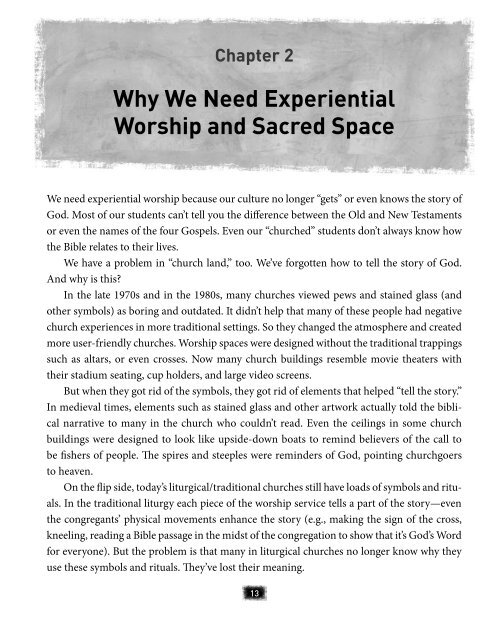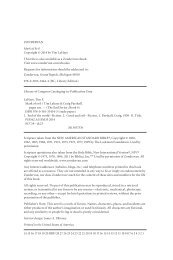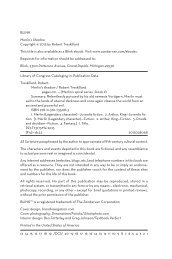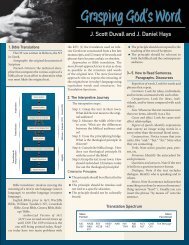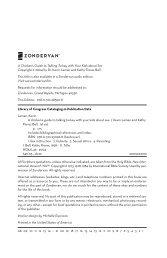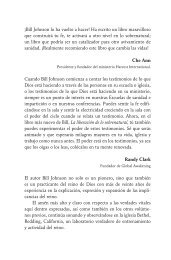Sacred Space: A Hands-On Guide to Creating Multisensory Worship ...
Sacred Space: A Hands-On Guide to Creating Multisensory Worship ...
Sacred Space: A Hands-On Guide to Creating Multisensory Worship ...
- No tags were found...
You also want an ePaper? Increase the reach of your titles
YUMPU automatically turns print PDFs into web optimized ePapers that Google loves.
Chapter 2Why We Need Experiential<strong>Worship</strong> and <strong>Sacred</strong> <strong>Space</strong>We need experiential worship because our culture no longer “gets” or even knows the s<strong>to</strong>ry ofGod. Most of our students can’t tell you the difference between the Old and New Testamentsor even the names of the four Gospels. Even our “churched” students don’t always know howthe Bible relates <strong>to</strong> their lives.We have a problem in “church land,” <strong>to</strong>o. We’ve forgotten how <strong>to</strong> tell the s<strong>to</strong>ry of God.And why is this?In the late 1970s and in the 1980s, many churches viewed pews and stained glass (andother symbols) as boring and outdated. It didn’t help that many of these people had negativechurch experiences in more traditional settings. So they changed the atmosphere and createdmore user-friendly churches. <strong>Worship</strong> spaces were designed without the traditional trappingssuch as altars, or even crosses. Now many church buildings resemble movie theaters withtheir stadium seating, cup holders, and large video screens.But when they got rid of the symbols, they got rid of elements that helped “tell the s<strong>to</strong>ry.”In medieval times, elements such as stained glass and other artwork actually <strong>to</strong>ld the biblicalnarrative <strong>to</strong> many in the church who couldn’t read. Even the ceilings in some churchbuildings were designed <strong>to</strong> look like upside-down boats <strong>to</strong> remind believers of the call <strong>to</strong>be fishers of people. The spires and steeples were reminders of God, pointing churchgoers<strong>to</strong> heaven.<strong>On</strong> the flip side, <strong>to</strong>day’s liturgical/traditional churches still have loads of symbols and rituals.In the traditional liturgy each piece of the worship service tells a part of the s<strong>to</strong>ry—eventhe congregants’ physical movements enhance the s<strong>to</strong>ry (e.g., making the sign of the cross,kneeling, reading a Bible passage in the midst of the congregation <strong>to</strong> show that it’s God’s Wordfor everyone). But the problem is that many in liturgical churches no longer know why theyuse these symbols and rituals. They’ve lost their meaning.13


